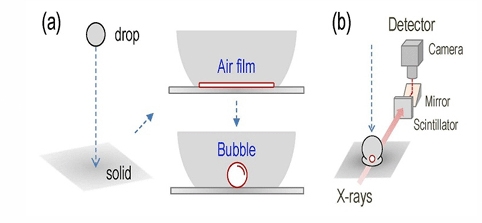It is claimed that the research could help eliminate bubbles formed during spray coating, metal casting and ink-jet printing. It also could impact studies on fuel efficiency and engine life by understanding the splashing caused by fuel hitting engine walls.
‘How liquid coalesces into a drop or breaks up into a splash when hitting something solid is a fundamental problem in the study of fluid dynamics,’ said Jung Ho Je, one of the lead authors of ‘How Does an Air Film Evolve into a Bubble During Drop Impact?’, published in the journal Physical Review Letters, and a physicist at Pohang University of Science and Technology in Korea.
A team of Korean and US scientists used the Advanced Photon Source (APS) at the US Department of Energy’s Argonne National Laboratory to profile the film of air that gets trapped between a droplet and a surface and to study how it evolves into a bubble.
Visualising this process required the use of X-ray phase-contrast imaging done at the APS’s 32-ID beamline, which captured bubble formation at a speed of 271,000 frames per second.
‘This is the first time we can clearly visualise the detailed profile of air dynamics inside of a droplet, which made understanding what forces are at play much easier,’ said Kamel Fezzaa, a physicist working at the APS.
It is known that the surrounding air pressure influences splashing, but it also leaves an air layer under the drop that evolves into a bubble. The researchers found that a ‘sweet spot’ exists for controlling whether the emerging bubbles stay attached to the substrate or detach and float away. This sweet spot is said to be a combination of the wetness of the surface material and the fluid properties of the droplet.
X-rays are an ideal tool for studying bubble formation as visual-light imaging techniques present issues in reflection and refraction, and interferometry and total internal-reflection microscopy techniques can’t track changes in the air thickness.
Scientists used the APS’s combination of phase-contrast imaging and ability to take 0.5 microsecond snapshots at intervals of 3.68 microseconds to create a new technique for tracking changes at the interface of air and liquid in real time.
Numerous studies during the last few years have revealed the trapped air under the droplet, but this is the first time the bubble profile and cause of collapse has been visualised and explained.
The planned APS upgrade will enable viewing of even faster occurrences and a wider field of view to capture the droplet and smaller bubble formation in the same video.
In future experiments, scientists plan to test whether other conditions such as the temperature of the impact surface or the pressure and nature of surrounding gases affect the bubble formation.






Project to investigate hybrid approach to titanium manufacturing
What is this a hybrid of? Superplastic forming tends to be performed slowly as otherwise the behaviour is the hot creep that typifies hot...